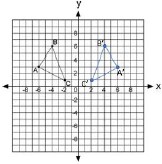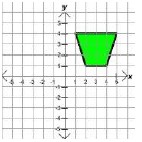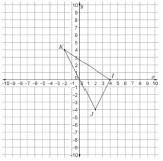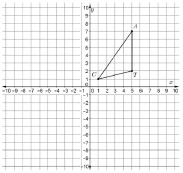General Information
Benchmark Instructional Guide
Connecting Benchmarks/Horizontal Alignment
- NA
Terms from the K-12 Glossary
- Coordinates
- Coordinate Plane
Vertical Alignment
Previous Benchmarks
Next Benchmarks
Purpose and Instructional Strategies
In grade 6, students plotted rational-number ordered pairs in all four quadrants as well as identified the - or -axis as a line of reflection when two ordered pairs have an opposite - or -coordinate. In grade 7, students solved mathematical and real-world problems involving scale factors. In grade 8, students apply a single transformation using coordinates and the coordinate plane. In Algebra 1, students will apply a single transformation to functions. In Geometry, students will describe transformations given a preimage and an image and represent the transformation algebraically using coordinates and use them to study congruence and similarity.- Use grid paper to illustrate translations of a line or triangle to demonstrate the relationship between them and a new image. Then, illustrate translations of more complex figures such as polygons.
- Transformations can be noted using the prime notation (′) for the image and its vertices. The preimage and its vertices will not have prime notation.
- For example, the picture below showcases a single transformation.

- For example, the picture below showcases a single transformation.
- Problem types include telling which direction, clockwise or counterclockwise, for rotations.
- Instruction includes looking for patterns to create rules for transformations on the coordinate plane.
- For mastery of this benchmark, single transformations include one vertical translation or one horizontal translation. A vertical and horizontal translation would be considered two transformations.
Common Misconceptions or Errors
- Students may incorrectly visualize transformation on the coordinate plane. To address this misconception, provide students with manipulatives.
- Students may incorrectly apply rules for transformations. To address this misconception, students should generate examples and non-examples of given transformations.
Strategies to Support Tiered Instruction
- Teacher supports understanding of transformations on the coordinate place by providing examples using geometric software. Instruction includes the use of manipulatives and graph paper.
- Teacher reminds students when plotting points on a coordinate plane that they can first find the -coordinate on the -axis (horizontal axis) and then find the -coordinate on the -axis (vertical axis).
- Teacher reviews vocabulary discussing the meaning of the terms.
- Translation is a vertical or horizontal slide of the figure. To determine the coordinates of the image of a translated figure you must add or subtract the horizontal distance to the -coordinate of each vertex and add or subtract the vertical distance to the -coordinate of each vertex. (Note that in later courses, students learn that translation can also occur diagonally.)
- Preimage is the figure before any transformations are performed.
- Image is the figure after a transformation is performed.
- Teacher co-creates a graphic organizer to generate examples and non-examples of reflections, translations, rotations, or dilations of images.
- Teacher provides instruction to support understanding of applying the translation to all vertices, not just one vertex.
- Teacher reviews directions of rotations. Clockwise is the direction the hands go on an analog clock
 . Counterclockwise is the opposite direction of the hands on an analog clock
. Counterclockwise is the opposite direction of the hands on an analog clock  .
.- For example, which quadrant would the image be in if you rotated the figure?
- 90 degrees clockwise
- 90 degrees counterclockwise
- 180 degrees clockwise
- 180 degrees counterclockwise

- For example, which quadrant would the image be in if you rotated the figure?
- Teacher reviews which is the -axis and which is the -axis for students that incorrectly reflect across the wrong axis. Teacher co-creates anchor chart explaining different parts of coordinate plane, and how to plot and label points.
- For example, teachers could ask students which quadrant the image would be in if you reflected the figure across the -axis or across the -axis.
- Instruction includes providing students with manipulatives for students that incorrectly visualize transformations on the coordinate plane.
Instructional Tasks
Instructional Task 1 (MTR.1.1, MTR.2.1)Use the information you have learned about transformations to complete the task below.
- Part A. Using graph paper, plot the following points to create an image on the coordinate plane. (−3,2), (0,1), (−3, −1) and (−1, −1)
- Part B. Using a different color for each transformation, complete each of the following transformations on the same coordinate plane.
a. A reflection over the -axis
b. A rotation of 180° about the origin - Part C. Will any of the new images include the origin?
Instructional Items
Instructional Item 1Find the coordinates of the vertices of the image of triangle after the translation 3 units to the left.

Instructional Item 2
Find the coordinates of the vertices of the image of triangle after a 270° counterclockwise rotation about the origin.

*The strategies, tasks and items included in the B1G-M are examples and should not be considered comprehensive.
